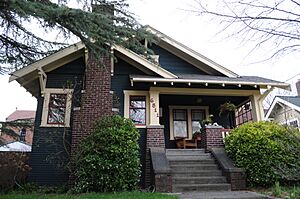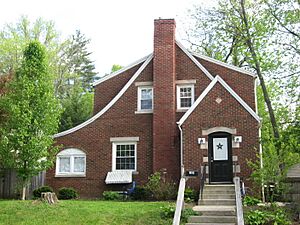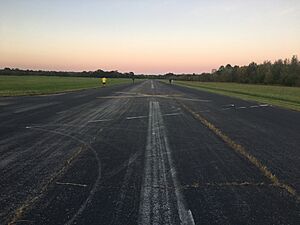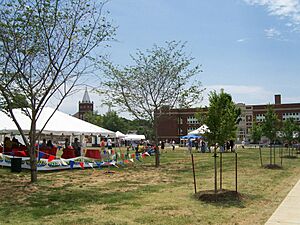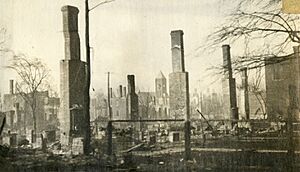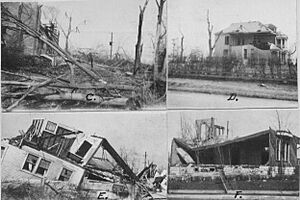East Nashville, Tennessee facts for kids
East Nashville is a lively area located just east of downtown Nashville in Tennessee. It sits across the Cumberland River from the city center. This area is mostly made up of homes and mixed-use spaces, with many businesses along its main roads like Gallatin Avenue and Ellington Parkway. Other important streets include Main Street, Shelby Avenue, and Woodland Street. Ellington Parkway helps connect different parts of Nashville, including Briley Parkway and downtown.
The Cumberland River forms a natural boundary around much of East Nashville. The exact borders on the west and north are sometimes debated. Some people think Ellington Parkway forms the western edge, while others believe I-24 and I-65 are the western borders. East Nashville is one of about 26 neighborhoods in the larger Nashville area.
Contents
Exploring East Nashville's Neighborhoods
The main part of East Nashville, found in ZIP Code 37206, has many smaller neighborhoods. Each one has its own special feel and types of houses. This area includes historic places like Edgefield, East End, and Lockeland Springs. These neighborhoods were greatly affected by the Great Fire of 1916 and a tornado in 1933. Further east, you'll find newer neighborhoods like Rosebank, which have homes built in the 1950s and 1960s.
The larger area known as Greater East Nashville includes ZIP codes 37216 and 37207. This wider area stretches west to I-65 and north to Briley Parkway. It includes neighborhoods like Highland Heights, Cleveland Park, McFerrin Park, and Inglewood.
East End: A Historic Community
The East End area started as farms and trading posts long ago. In 1876, it became an extension of the stylish Edgefield community. It was called the East Edgefield addition but soon became known as East End. This was because it was on the eastern edge of the city. By the early 1900s, many families lived here. They built homes that showed off the detailed designs of the Victorian era. People liked the area because it was quiet and had less pollution. East End grew into a stable and attractive neighborhood close to the city.
Historic Edgefield: A Story of Change
Edgefield was once Nashville's most exclusive suburb. Its streets were lined with grand homes in styles like Italianate and Queen Anne. While some of these beautiful homes still stand, many were lost in the Great Fire of 1916. Later, new neighborhoods like Lockeland and East End grew as large farms were divided into smaller lots. A powerful tornado also hit parts of East Nashville in 1933. In the 1970s, people began moving into the area and fixing up old homes. This process is sometimes called gentrification.
Lockeland Springs: A Name from History
Lockeland was named in 1880 when this area was first being developed. The name comes from the Weakley family, who built their home near the original Fort Nashborough. Jane Locke was the wife of Col. Robert Weakley. Their home, called Lockeland, was built in 1790. Over the years, the property changed hands. Later additions, like a tower, were built long after the Weakley family owned the land.
Green Spaces and Parks
Shelby Park: Fun and Nature
In the 1890s, Nashville Railway built an amusement park in Shelby Park. This park closed by 1903. In 1909, the city of Nashville bought the land. They dug a lake and used the dirt to build roads through the park. People enjoyed plays, paddleboats, and picnics at Sycamore Lodge. Today, Shelby Park is still a popular spot. Shelby Bottoms, right next to it, is the largest natural preserve in the Nashville area.
Shelby Bottoms: A Large Natural Area
Shelby Bottoms Greenway is a huge park, about 810 acres in size. It stretches for about three miles long and half a mile wide. Shelby Park is its southern border, and the Cumberland River runs along its east side. Most of this area was once farmland before it became a park in 1994. It has open fields and wooded areas with native trees. Shelby Bottoms offers about eight miles of paved trails for walking and biking. It also has five miles of dirt trails, an observation deck, and river overlooks.
Cornelia Fort Airpark: A Unique Addition
Cornelia Fort Airpark was a private airport located near the Cumberland River in East Nashville. It operated from 1944 until 2011.
In 2011, Nashville bought the Cornelia Fort Airpark. This airport was the destination of singer Patsy Cline's fatal plane crash in 1963. When combined, Shelby Park, Shelby Bottoms, and Cornelia Fort make up over 1,000 acres. This makes it one of the largest park complexes in Nashville.
East Park: A Community Gathering Spot
East Park was created after the Great Fire of 1916. Before the fire, homes from the late 1800s stood here. After the fire destroyed them, the city cleared the land and made East Park. It runs between 6th and 8th Streets, bordering Woodland and Russell Streets. This park provides a green space for the East End, Edgefield, and McFerrin Park neighborhoods. Architect Donald W. Southgate designed a bandstand for the park, but it was removed in 1956.
Cumberland Park: Modern Riverfront Fun
Cumberland Park is one of East Nashville's newest parks. It was built along the east bank of the Cumberland River in downtown Nashville. The park is located just south of Nissan Stadium, between the Shelby Street Pedestrian Bridge and the Gateway Bridge. This area used to be an industrial riverfront with factories. Now, it's a modern park that cost about $17 million to create. It's part of a larger plan to develop the riverfront.
Other parks in East Nashville include Kirkpatrick Park, Cleveland Park, Douglas Park, and McFerrin Park.
East Nashville's Rich History
The Great Fire of 1916
On the morning of March 22, 1916, a huge fire broke out in East Nashville. It destroyed over 500 houses and left more than 2,500 people without homes. The fire started at Joe Jennings' home, next to a lumber mill. Sparks from his home set the mill on fire, and from there, the blaze quickly spread.
Strong winds, blowing at 44–51 miles per hour, caused the fire to spread very fast across wooden roofs. This made it hard for the Nashville fire department to control the flames. People formed "bucket brigades" to help fight the fire. Many quickly moved their furniture out of their homes to save their belongings. Fire Chief Rozetta asked other cities for help, and the Governor mobilized the Tennessee National Guard.
Several buildings, including a church and a school, burned to the ground. However, Tulip Street Methodist Church and St. Ann's Episcopal Church survived. This was thanks to church members who left their burning homes to save them. The fire destroyed all of East Nashville southeast of Fifth and Woodland Street. The total damage was estimated at over $1.5 million.
The Tornado of 1933
March 14, 1933, was an unusually warm day in Nashville. A powerful cold front was moving in. The temperature reached 80 degrees, which was very early in the year for such warmth. A fast-moving storm brought heavy rain and the deadliest tornado in Nashville's history. The tornado started west of downtown and quickly became stronger. It passed very close to the State Capitol building, shaking glass from its windows. Then, it hit the north side of Public Square downtown, damaging several buildings.
The tornado then crossed the Cumberland River into East Nashville, north of the Woodland Street Bridge. It traveled eastward, widening its path to 600 to 800 yards. For three miles, the tornado tore through homes, churches, schools, and stores. It damaged 1,400 homes, 16 churches, 36 stores, and many other buildings. The tornado then continued towards Donelson and Hermitage before weakening.
After the storm, police, National Guardsmen, Red Cross workers, Boy Scouts, and Salvation Army members rushed to help. There was very little looting or panic. The guardsmen stayed on duty until the city was under control. The day after the storm, telegraph and telephone companies were very busy with messages from residents to their families. By Thursday morning, work crews had cleared the streets. Relief agencies helped storm victims with shelter, clothing, and food.
Cable Streetcars: Early Transportation
In the early 1900s, Nashville had a network of electric cable cars. These streetcars made it easy for people living in the suburbs to get to downtown Nashville. Percy Warner, from a famous Nashville family, owned these streetcars. He was interested in electric utilities and city transportation. From 1903 to 1914, he ran the Nashville Railway and Light Company, which controlled all the city's streetcars.
The Tornado of 1998
East Nashville was hit by another tornado on April 16, 1998. This tornado was part of a larger storm system that affected the Nashville area. At least 300 homes in East Nashville were damaged. Many lost parts of their roofs, and a few were completely destroyed. A church that was over 100 years old also suffered major damage. Trees were pulled out of the ground, and telephone poles were knocked down.
East Nashville Today
East Nashville is known for its creative and artistic vibe. It has a trendy and progressive atmosphere. Over the past ten years, the neighborhood has grown steadily while keeping its unique, artsy feel. It attracts young professionals and people with open minds. This is because of its relaxed environment and charming neighborhood qualities. You'll find many coffee shops and art galleries here, making it a great place for walking or biking.
The Tomato Art Fest is a popular summer festival in East Nashville. It takes place specifically at Five Points, where Woodland, Clearview, and 11th streets meet. Many other festivals and fairs happen throughout the year. New homes are being built in the outer neighborhoods, which has caused home prices to rise. More young people are choosing to live here.
Cumberland Park, located on the east bank of the Cumberland River, is a great example of new developments. It sits near Nissan Stadium. This area used to be industrial, but now parks are being built along both sides of the river. The project also included renovating the old Nashville Bridge Co. building. This building now has offices, food stands, and public restrooms. Nashville's new riverfront development is much larger than the existing Riverfront Park on the west side of the river.
In 2017, Mayor Megan Barry dedicated the first historical marker in Tennessee to honor an LGBT activist, Penny Campbell, in East Nashville.
Today, East Nashville also has some public housing projects. These include James A. Cayce, Sam Levy Homes, and Parkway Terrace. James A. Cayce, the largest project, is being torn down and replaced with newer housing as part of the Envision Cayce plan. Sam Levy Homes has also been updated with newer public housing.
East Nashville's Future Plans
Nashville is working to become more urban and less spread out. East Nashville is a neighborhood that is thinking carefully about its future. The city wants to create an urban environment similar to Seattle, Washington or Portland, Oregon. Nashville, including East Nashville, is trying to set stricter building rules. They also want to design the city more for people walking than for cars.
There are also plans for a mass transit train system. This system would run from East Nashville to midtown, just west of downtown Nashville. In "The Plan of Nashville," Gallatin Pike is expected to have a complete redesign. The east bank of the Cumberland River will also change a lot. Nissan Stadium will be surrounded by greenways and streets designed for walking.



